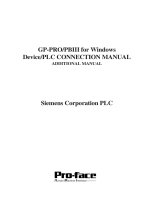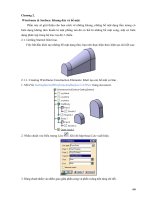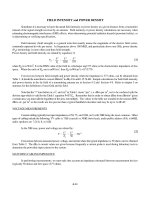Tài liệu Electrical safety and ( http://thisisplc.blogspot.com) pdf
Bạn đang xem bản rút gọn của tài liệu. Xem và tải ngay bản đầy đủ của tài liệu tại đây (124.12 KB, 12 trang )
Electrical
safety
and you
1
INTRODUCTION
Electricity can kill. Each year about 1000 accidents at work involving electric shock
or burns are reported to the Health and Safety Executive (HSE). Around 30 of
these are fatal. Most of these fatalities arise from contact with overhead or
underground power cables.
Even non-fatal shocks can cause severe and permanent injury. Shocks from faulty
equipment may lead to falls from ladders, scaffolds or other work platforms.
Those using electricity may not be the only ones at risk: poor electrical
installations and faulty electrical appliances can lead to fires which may also cause
death or injury to others. Most of these accidents can be avoided by careful
planning and straightforward precautions.
This leaflet outlines basic measures to help you control the risks from your use of
electricity at work. More detailed guidance for particular industries or subjects is
listed on pages 6 - 8. If in doubt about safety matters or your legal responsibilities,
contact your local inspector of health and safety. The telephone number of your
local HSE office will be in the phone book under Health and Safety Executive. For
premises inspected by local authorities the contact point is likely to be the
environmental health department at your local council.
WHAT ARE THE HAZARDS?
The main hazards are:
■ contact with live parts causing shock and burns (normal mains voltage,
230 volts AC, can kill);
■ faults which could cause fires;
■ fire or explosion where electricity could be the source of ignition in a
potentially flammable or explosive atmosphere, eg in a spray paint booth.
ASSESSING THE RISK
Hazard means anything which can cause harm.
Risk is the chance, great or small, that someone will actually be harmed by the
hazard.
2
The first stage in controlling risk is to carry out a risk assessment in order to
identify what needs to be done. (This is a legal requirement for all risks at work.)
When carrying out a risk assessment:
■ identify the hazards;
■ decide who might be harmed, and how;
■ evaluate the risks arising from the hazards and decide whether existing
precautions are adequate or more should be taken;
■ if you have five or more employees, record any significant findings;
■ review your assessment from time to time and revise it if necessary.
The risk of injury from electricity is strongly linked to where and how it is used.
The risks are greatest in harsh conditions, for example:
■ in wet surroundings - unsuitable equipment can easily become live and
can make its surroundings live;
■ out of doors - equipment may not only become wet but may be at
greater risk of damage;
■ in cramped spaces with a lot of earthed metalwork, such as inside a tank
or bin - if an electrical fault developed it could be very difficult to avoid
a shock.
Some items of equipment can also involve greater risk than others. Extension
leads are particularly liable to damage - to their plugs and sockets, to their
electrical connections, and to the cable itself. Other flexible leads, particularly
those connected to equipment which is moved a great deal, can suffer from
similar problems.
More information on carrying out risk assessments is available in other HSE
publications listed on page 6 of this leaflet.
REDUCING THE RISK
Once you have completed the risk assessment, you can use your findings to
reduce unacceptable risks from the electrical equipment in your place of work.
There are many things you can do to achieve this; here are some.
Ensure that the electrical installation is safe
■ install new electrical systems to a suitable standard, eg BS 7671 Requirements
for electrical installations, and then maintain them in a safe condition;
■ existing installations should also be properly maintained;
■ provide enough socket-outlets - overloading socket-outlets by using
adaptors can cause fires.
Provide safe and suitable equipment
■ choose equipment that is suitable for its working environment;
■ electrical risks can sometimes be eliminated by using air, hydraulic or hand-
powered tools. These are especially useful in harsh conditions;
■ ensure that equipment is safe when supplied and then maintain it in a safe
condition;
■ provide an accessible and clearly identified switch near each fixed machine
to cut off power in an emergency;
■ for portable equipment, use socket-outlets which are close by so that
equipment can be easily disconnected in an emergency;
■ the ends of flexible cables should always have the outer sheath of the cable
firmly clamped to stop the wires (particularly the earth) pulling out of the
terminals;
■ replace damaged sections of cable completely;
■ use proper connectors or cable couplers to join lengths of cable. Do not
use strip connector blocks covered in insulating tape;
■ some types of equipment are double insulated. These are often marked with
a ‘double-square’ symbol . The supply leads have only two wires - live
(brown) and neutral (blue). Make sure they are properly connected if the
plug is not a moulded-on type;
■ protect lightbulbs and other equipment which could easily be damaged in
use. There is a risk of electric shock if they are broken;
■ electrical equipment used in flammable/explosive atmospheres should be
designed to stop it from causing ignition. You may need specialist advice.
Reduce the voltage
One of the best ways of reducing the risk of injury when using electrical equipment
is to limit the supply voltage to the lowest needed to get the job done, such as:
3









